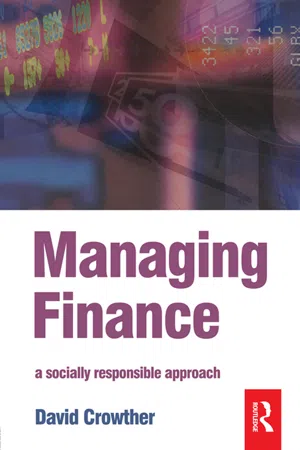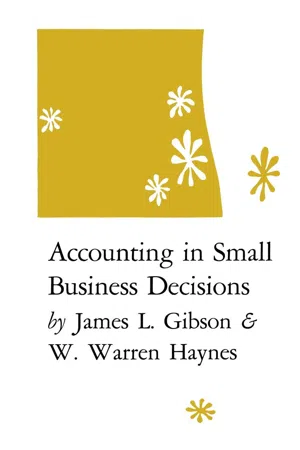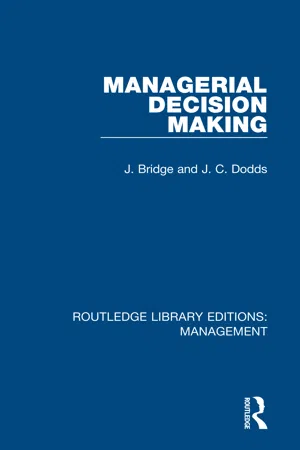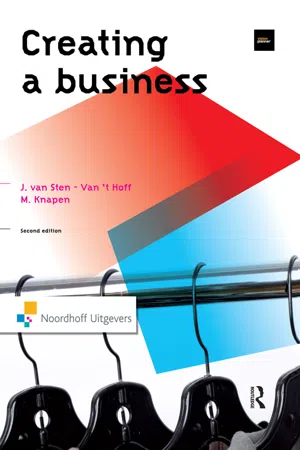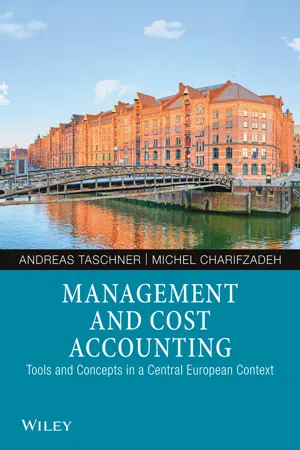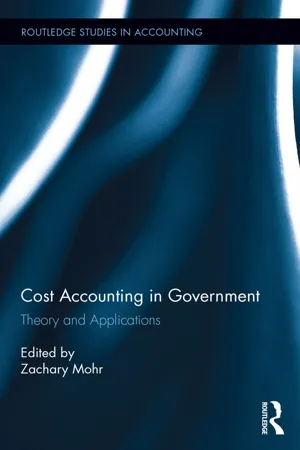Economics
Cost Accounting
Cost accounting is a branch of accounting that focuses on analyzing, recording, and reporting costs associated with production processes, activities, and products. It provides valuable information for decision-making, cost control, and performance evaluation within an organization. Cost accounting methods help in determining the cost of goods sold and in assessing the efficiency and profitability of business operations.
Written by Perlego with AI-assistance
Related key terms
8 Key excerpts on "Cost Accounting"
- eBook - ePub
- D. Crowther(Author)
- 2007(Publication Date)
- Routledge(Publisher)
Both fixed and variable cost relationships only hold true within a specific range of activities, which is termed the relevant range, and outside this range the relationship no longer holds true. For example, with fixed costs an increase in the level of activity beyond a particular point may necessitate the introduction of a new production plant or an additional assembly line, hence causing an increase in the level of fixed costs. Fixed costs tend to increase in steps rather than gradually as the level of activity increases and these increases are known as ‘stepped costs’ in the production process. For variable costs the changes tend to be more gradual but, for example, an increase in activity may result in the need to recruit extra labour, or to work overtime at premium rates, or to introduce a shift working pattern. The effect of this is to change the unit cost of production beyond a particular level of activity and to move the variable cost behaviour into a different cost behaviour relationship. In predicting costs therefore it is necessary to recognise the relevant range within which particular cost behaviour applies.Economics v. AccountingEconomic theory suggests that costs behave in a predictable way, whatever the range of activity and that one cost function applies to all levels of activity. Economic theory further suggests that a cost function is not linear, but rather curvilinear. The difference between costs in accounting and in economics is considered in detail in Chapter 4 .Multiple Causes of BehaviourIt is often assumed that a variable cost is related to the level of production and varies directly with changes in the level of production. In reality variable costs may vary in relation to a number of different activities within the production process. Thus, for example, labour costs may vary according to the number of orders received, or the number of batches processed, or the number of times machines need to be reset for different production processes, or more likely to a combination of such reasons. It is an oversimplification to relate all variable costs to one activity measure, such as output, but one that is frequently assumed by manufacturing companies. Such an assumption, however, is often sufficient to classify costs for prediction purposes. At other times, however, the results from this may be misleading and it is for this reason that other methods of determining cost relationships have been developed. Activity-based costing is one such method which we will consider in greater detail in Chapter 8 .The Objectives of Cost ClassificationIn order to consider how we might wish to classify the cost information which is available to us in a useful way it is a good starting point to consider the objectives which we have in mind for such a classification. Broadly speaking there are three reasons or objectives for wishing to classify costs, namely: - eBook - ePub
- James L. Gibson, W. Warren Haynes(Authors)
- 2021(Publication Date)
- The University Press of Kentucky(Publisher)
The fact that accounting does not do everything that economic theory might ask of it is not necessarily a criticism of accounting practices. Since traditional accounting and economics are concerned with different questions, it should be no surprise that they often find different answers. There can be no dogmatic conclusions about what degree of theoretical refinement is justified in practical, day-to-day business, especially the small business in which the expenses of refinement are a real barrier to the full application of economic analysis. We hope that an intensive study of actual cases will help determine the extent to which small firms can afford to carry their analysis, whether this analysis is accounting or economic in character.1 Kenneth E. Boulding, A Reconstruction of Economics (New York: John Wiley & Sons, Inc., 1950), p. 27.2 See National Association of Cost Accountants, Direct Costing , N.A.C.A. Research Report No. 23, April 1, 1953.3 See James S. Earley, “Recent Developments in Cost Accounting and the ‘Marginal Analysis,’” Journal of Political Economy , LXIII (June, 1955), 227-42.4 See Robert I. Jones, Merchandise Management Accounting in Practice (Chicago: Arthur Anderson and Co., 1957); special issue on merchandise management accounting, Journal of Retailing , XXXIV (Spring, 1958); Malcolm P. McNair and Eleanor G. May, “Pricing for Profit: A Revolutionary Approach to Retail Accounting,” Harvard Business Review , XXXV (May-June, 1957), 105-22.5 “Tailor-Making Cost Data for Specific Uses,” N.A.C.A. Bulletin ,1954 Conference Proceedings , pp. 1691-1707. Reprinted in William E. Thomas, Jr. (ed.), Readings in Cost Accounting, Budgeting and Control (Cincinnati: South-Western Publishing Co., 1955), pp. 314-32.6 Joel Dean, Managerial Economics (Englewood Cliffs, N. J.: Prentice-Hall, 1951), pp. 12-28.7 These remarks refer to the traditional core of accounting. Accounting can be defined broadly to permit estimates, judgments, predictions, and the other features required by managerial economics. For a broad definition of accounting, see “Report of the Committee on Management Accounting,” Accounting Review - Franz Schmithüsen, Bastian Kaiser, Albin Schmidhauser, Stephan Mellinghoff, Karoline Perchthaler, Alfred Kammerhofer(Authors)
- 2015(Publication Date)
- Routledge(Publisher)
The form and content of managerial accounting are largely at the company’s discretion. This is because it addresses primarily internal structures, problems, business units and management staff, which vary considerably from company to company. Monitoring and controlling production processes and business activities demand a flexible, modular structure that can be adjusted to changing information needs. Such a structure makes communication among everyone involved easier and more cost-effective – important because managerial accounting must be fast in drawing attention to new opportunities or emerging problems.Two interesting publications specifically address managerial economics and accounting as they relate to the evolving paradigm of sustainable natural resources management: Austrian Journal of Forest Science (2009) and Jöbstl and Roder (2009). Both documents deal, in particular, with the economic and financial aspects of multifunctional forest production. They address the integration of marketable goods and services with external payments for nonmarketable, or not-yet-marketable, environmental and social benefits in business accounting, national accounting and public reporting.5.3.1 Cost Accounting
Cost Accounting consists of three central elements that are functionally related:- – In cost type accounting all costs – personnel, energy, materials – that arise during a determined period for the company’s output provisions are recorded and categorised. Adjustments to financial accounting are made and imputed costs are shown.
- – In cost centre accounting the recorded costs are allocated to objects and activities from which they originate. Cost centres are internal functional and organisational units of a company that have clearly delineated business functions and to which calculated or standard costs per production unit can be assigned. In sustainable wood production, for example, costs can be structured according to planting and natural regeneration, tending of young stands, pre-commercial thinning, harvesting of mature timber stands, skidding and transport of harvested trees and sales of different wood assortments. In sawmills this type of classification may involve roundwood storage, debarking units, sawing aggregates, sawnwood drying and storage, use of collateral products and purchasing and sales units.
- eBook - ePub
Production and Cost Functions
Specification, Measurement and Applications
- Erkin Bairam(Author)
- 2018(Publication Date)
- Routledge(Publisher)
It is a level of analysis that is usually not of a great deal of interest or concern to an economist. However, if this theory of accounting measurement is indeed an accurate numerical representation of real world attributes, these ‘atomic level’ elements must eventually aggregate to provide the basis for the kind of production functions which enter in micro-economic and ultimately macro-economic analysis. The idea of a measurable economy consisting of a collection of dated activity costs may be understood in the following manner. All the resources of an economy are partitioned into activities by the matching relation. Firms are simply subsets of collections of these activities and financial statements are systematic records based upon all the transactions costs of particular firms classified into activities up to some point in time. This representation is useful as a basic framework for understanding accounting measurements and the relation of the accountant’s concept of production and cost fonctions to the economist’s concepts because it allows one to see how the fundamental measures of accounting are used to construct derived accounting measures. Activities start, continue and finish over a period of time and the value of accounting performance measures (the most important of which is accounting ‘earnings’ shown in the income statement) are ultimately determined by recognition rules based upon primary measurements of these variables. 17 This is a particularly important point for the economist to appreciate - eBook - ePub
- J. Bridge, J. C. Dodds(Authors)
- 2018(Publication Date)
- Routledge(Publisher)
4 Cost Analysis 4-1 Introduction Cost in its broadest sense means sacrifice, typically a sacrifice of purchasing power, but it is important to think of the wider meaning because it is possible to incur costs without any transfer of cash taking place. Business decisions revolve around private costs which include all outlays made by the firm on materials, labour, land, capital, energy and so on. Social costs, i.e. those sacrifices made by society, to enable businesses to operate include damage to the environment through smoke and waste products, spoilage of the appearance of the landscape, congestion of roads, and disruption of community life. Any organisation with an objective of public responsibility will of course pay heed to social costs such as these, but in so far as they do not influence the profits of a firm directly they tend to take second place to private costs which do have a direct influence on the well-being of the organisation. The usual problems of estimation and informational deficiencies are compounded by the lack of an unequivocal definition of cost. In practice it is impossible to give a straightforward answer to the question, ‘What is the cost of producing this item?’ This applies to the book you are now reading, the table at which you are sitting and indeed almost any other manufactured product you could mention. Yet for purposes of cost control or managerial decision making it is vital that some financial measure is ascribed to cost. It is rather easier to provide figures for control purposes than it is for evaluation of alternatives since control relies on comparison of reality with predetermined standards to detect variations from the desired state of affairs (see Chapter 1). So long as some benchmark for product cost is set the control system can be workable through the detection of variances. Consequently managers must be very wary when evaluating alternatives, of using cost information prepared by accountants largely for control purposes - eBook - ePub
- Jenny van Sten-van't Hoff(Author)
- 2019(Publication Date)
- Routledge(Publisher)
7 Management accounting aspects7.1 Cost concepts 7.2 Decision management versus decision control 7.3 Opportunity costs 7.4 Activity-based costing (ABC) 7.5 Cost-volume-profit (CVP) analysis 7.6 The budgeting process 7.7 Risk management 7.8 VisionplannerIn any business plan the key strategic decisions for a manager include what to produce, what quantity to sell or at what price, and which combination and quantity of various inputs, such as material, labour and capital, to use. These decisions also include how to sell the product, as outlined in chapter 4 , and the quality of the various inputs. If the manager wants to maximise value, he must decide how much of each output to produce. This looks simpler than it is: how are revenues and cost estimated? Information about future costs and revenues is usually not readily available, but must be estimated by the manager, thus involving risks and uncertainty.Section 7.1 starts by identifying various cost concepts. The role of cost information in decision management and decision control is explored in section 7.2 . Section 7.3 explains the concept of opportunity costs. The steps in activity-based costing are explained in section 7.4 . The interrelationships between costs, volume and profit are discussed in section 7.5 . A key instrument in the business planning, the budgeting process, is discussed in section 7.6 . Finally, risks in the management accounting process are explored in section 7.7 .Where relevant, the chapter refers to the software and the last section shows the link between the software and the book.7.1 Cost conceptsCost objectivesThe user of accounting information wants to know the cost of a product, or of rendering a service. The product or service is called a cost objective. Cost objectives can be divided into three broad categories: costs for inventory valuation, costs for decision making and costs for decision control. For each of these three categories, costs may be classified as follows: - eBook - ePub
Management and Cost Accounting
Tools and Concepts in a Central European Context
- Andreas Taschner, Michel Charifzadeh(Authors)
- 2020(Publication Date)
- Wiley-VCH(Publisher)
Flexibility: Many companies today are faced with unstable, very dynamic business environments. New challenges must be tackled, yet-unknown business problems must be solved, and new information needs arise as a consequence. Cost Accounting systems must be able to adapt to these changing information needs as well. New cost units might have to be implemented, previous allocation routines must be changed, new cost types arise when production technologies are changed, etc. The Cost Accounting system therefore should be flexible enough to adapt to these changes without causing too many interruptions.Cost Effectiveness:Finally, Cost Accounting as a business function is subject to the same efficiency imperative that guides all corporate functions: Tasks must be performed at the lowest cost possible, without sacrificing effectiveness. A cost effective Cost Accounting system therefore fulfills its tasks at lowest cost possible.Is the perfect Cost Accounting system possible?Unfortunately for Cost Accounting, these dimensions are partly in opposition to each other and it therefore is all but impossible to implement a Cost Accounting system that shows superior performance in each of these dimensions. Timeliness and accuracy, for instance, are usually possible to achieve only at higher costs. Completeness often is in opposition to timeliness, since it usually takes more time to collect and analyze all or more detailed data.Fortunately, in turn, the importance of these Cost Accounting principles differs between companies. Hardly any company will place emphasis on all dimensions. Instead, certain aspects (e.g. timeliness) are more important than others. Cost Accounting systems therefore must take into account the specific demands of information users within the company. Combining the demands on the Cost Accounting system in each dimension, it is possible to derive a “cost information demand profile” for the company, which is one of the key determinants when drafting the Cost Accounting system. - eBook - ePub
Cost Accounting in Government
Theory and Applications
- Zachary Mohr, Zachary Mohr(Authors)
- 2017(Publication Date)
- Routledge(Publisher)
2 Contextualizing Cost Accounting in Government From a Historical Perspective Zachary T. Mohrand William C. RivenbarkRecent work has shown that Cost Accounting has been an important part of government financial management since at least the turn of the 20th century (Rivenbark, 2005; Williams, 2004). The research has shown that at different periods, it has been important for budgeting, accounting, and performance measurement. In spite of its historical significance, it has never been a completely unifying financial management tool that some have projected it to be (Premchand, 2006). This chapter looks to contextualize Cost Accounting from the lens of history and to see what Cost Accounting tools or techniques developed during different periods. It also seeks to understand why Cost Accounting has struggled to live up to its potential to support various aspects of government financial management.To achieve these research objectives, we start by asking two basic questions about Cost Accounting in government. First, what are the stages and major developments of Cost Accounting? Second, in spite of its early promise and use, why has Cost Accounting been historically “limited” in achieving its potential? We explore the history of Cost Accounting with three distinct stages in response to the first objective: the early years (1885–1940), the technical years (1941–1970), and the modern years (1971–present). We then present a conceptual model of the relationship between Cost Accounting and other financial management tools that suggests both the reasons for its use and why it has received less attention in the modern years.The Early Years: 1885–19401
Although modern methods of Cost Accounting were introduced in the United States during the 1800s, the use of Cost Accounting in such countries as England, Germany, and Italy is documented as early as the 14th century (Brown, 1905; Garner, 1954). Most scholars cite Henry Metcalf’s Cost of Manufactures
Index pages curate the most relevant extracts from our library of academic textbooks. They’ve been created using an in-house natural language model (NLM), each adding context and meaning to key research topics.
